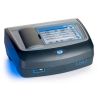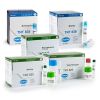Hach Phosphorus (Reactive and Total) TNTplus Vial Test
For determination of Reactive (ortho) and Total Phosphorus (phosphate) in wastewater, drinking water, boiler water, surface water and process water.
Features
- Easy and safe handling
- No reagent blank necessary
- Automatic method detection
- Expedited repair and warranty service
- Lifetime technical support
- More
Phosphorus TNTplus chemistry and your Hach spectrophotometer are engineered to simplify water analysis for accurate results, every time.
For determination of Reactive (ortho) and Total Phosphorus (phosphate) in wastewater, drinking water, boiler water, surface water and process water. TNTplus phosphorus reagents can provide an Orthophosphate or Total Phosphorus result.
Ascorbic Acid Method is Equivalent to EPA 365.1.
Phosphorus TNTplus chemistry allows you to test for reactive or total phosphorus with each vial. Follow the easy to navigate procedure printed on the lid of the box and then insert the TNTplus vial into your Hach spectrophotometer for an immediate result. Measurments are reported in the low range of 0.15 - 4.50 mg/L as PO4. If you are required to digest your phosphorus sample, performing this step in the sealed vial eliminates loss to evaporation and allows up to 30 simultaneous digestions depending on which DRB200 Reactor Block you are using.
Phosphates present in organic and condensed inorganic forms (meta-, pyro- or other polyphosphates) are first converted to reactive orthophosphate in the total phosphorus procedure. Treatment of the sample with acid and heat provides the conditions for hydrolysis of the condensed inorganic forms. Organic phosphates are also converted to orthophosphates in the total phosphorus procedure by heating with acid and persulfate. The reactive phosphorus procedure measures only the reactive (ortho) phosphorus present in the sample.
Phosphorus, Reactive (Ortho)
Phosphorus, Total
(0.15 - 4.5 mg/L PO₄)
In The News
Wildfire Prevention in the Sierra Nevada Region with the Yuba Watershed Institute
Though recent wildfires have sparked new conversations about wildfire management and response, groups like the Yuba Watershed Institute have been monitoring the forests and water resources of the Sierra Nevada region for decades, managing approximately 5,000 acres of land with the Bureau of Land Management (BLM) and about 7,000 acres in private land partnerships. The goal of the Institute is to work with local communities and land agencies to improve watershed and forestry management through informed practices and public outreach. The goals of the Yuba Watershed Institute are three-fold: Improve the ability of fire suppression agencies like the California Department of Forestry and Fire Protection ( CAL FIRE ) and the US Forest Service.
Read MoreWave Sensors Integration with NexSens Buoys: A Cutting-Edge Solution for Wave Measurment
Real-time wave data supports accurate weather prediction, safe and efficient maritime operations, and provides valuable safety and operating condition information for recreation and commercial fishing. Understanding wave dynamics also helps with the design of protective coastal structures like seawalls, breakwaters, and jetties. It also supports better prediction of their impact on sediment transport and coastal geomorphology. Wave data is a key factor in qualifying and designing offshore wind farms and harnessing kinetic energy for electrical generation. It helps with the understanding of ocean-atmosphere interactions and contributes to studies of sea-level rise and climate change impacts.
Read MoreSpring 2025 Environmental Monitor Available Now
In the Spring 2025 edition of the Environmental Monitor, we highlight partnerships across the world and the importance of collaboration between government agencies, universities, environmental groups, local communities, and other stakeholders. From great white shark research in Cape Cod to monitoring fisheries in Lake Erie, this latest edition underscores partnerships that connect stakeholders in a watershed through environmental data. With an emphasis on data sharing, a combination of real-time and discrete sampling keeps the public and partners informed of environmental conditions. Our writers also sought out science professionals dedicated to working with peers within and outside of the environmental sector.
Read More










